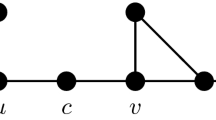Abstract.
An intersection representation of a graph G is a function f:V(G)→2S (where S is any set) with the property that uv∈E(G) if and only if f(u)∩f(v)≠∅. The size of the representation is |S|. The intersection number of G is the smallest size of an intersection representation of G. The intersection number can be expressed as an integer program, and the value of the linear relaxation of that program gives the fractional intersection number. This is in consonance with fractional versions of other graph invariants such as matching number, chromatic number, edge chromatic number, etc.
We examine cases where the fractional and ordinary intersection numbers are the same (interval and chordal graphs), as well as cases where they are wildly different (complete multipartite graphs). We find the fractional intersection number of almost all graphs by considering random graphs.
Similar content being viewed by others
Author information
Authors and Affiliations
Additional information
Received: July 1, 1996 Revised: August 11, 1997
Rights and permissions
About this article
Cite this article
Scheinerman, E., Trenk, A. On the Fractional Intersection Number of a Graph. Graphs Comb 15, 341–351 (1999). https://doi.org/10.1007/s003730050068
Issue Date:
DOI: https://doi.org/10.1007/s003730050068




